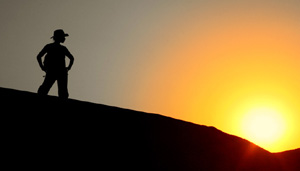|
Trekking often refers to
multi-day hiking trips through rural, often rugged
territory. Many people who are trekkers engage in
longer trips through entire regions of the world,
using trekking as a way of getting from place to
place. It can be incorporated with a number of other
outdoor sports, such as rock climbing or back
packing.
Trekking is different from
other sorts of travel for a few different reasons.
It tends to be less-structured than other sort of
travel, as weather conditions and topography help
influence travel plans more than plane flights or
hotel availability. As travelers move on foot
through often-rural areas, trekking gives travelers
an up-close view of incredible scenery. Many
trekkers travel through isolated areas, giving them
an experience much different than those who travel
in organized groups to more-popular destinations. It
often allows them to interact with nature, doing
anything from climbing a rock wall to navigating
across a mountain or entire mountain range.
 Trekking can be done anywhere
in the world. Trekking can result in a trip as long
or short as participants decide, from trips of a
week or more to expeditions that last more than a
year. Trekking can be as athletic and adventurous as
participants decide. The less-structured nature of
trekking and a world of destinations help attract a
wide variety of participants to the activity. Trekking can be done anywhere
in the world. Trekking can result in a trip as long
or short as participants decide, from trips of a
week or more to expeditions that last more than a
year. Trekking can be as athletic and adventurous as
participants decide. The less-structured nature of
trekking and a world of destinations help attract a
wide variety of participants to the activity.
Several pieces of gear help
make trekking more enjoyable. One is a
comfortably-fitting backpack. Many trekkers travel
for extended periods and need to carry all of their
belongings with them. A sturdy backpack can
comfortably fit more than 10- 20 kg. of clothing and
gear. Another important item is sturdy hiking shoes.
When covering long distances, wearing the right pair
of boots can make the difference between enjoying a
trip and being in pain. Other survival equipment,
such as warm clothing, a first aid kit and a supply
of food and water are also very important.
Trekking is best attempted
initially with someone who has experience or in a
professionally-led group. This can help introduce
those new to trekking to the special skills required
to successfully make an overland journey of
significant length. A number of outdoor stores and
organizations offer classes and plan trips that can
help give an idea of the gear and physical ability
required in trekking.
It is recommended that each
trekkers carry the following items :
1. Wind-proof jacket with parka
1 no.
2. Sweaters 2 full sleeves 1 half sleeve
3. Balaclava (Monkey cap) 1 no.
4. Woollen and leather gloves 1 pair each
5. Woollen/cotton long johns 2 pairs
6. Woollen socks 4 pairs
7. Cotton socks 4 pairs
8. Jeans|Pants 3 nos.
9. Shorts 2 nos.
10. Shirts/T-shirt 6 nos.
11. Sun glasses (good quality), with chain 1 no. for
hanging around neck.
12. Hunter/Marching/Trekking shoes 2 pairs (Carry
extra shoe laces- normal shoes will be useless for
Trekking)
13. Peaked cap or broad brimmed straw hat 1 no. (for
protection against the sun)
14. Water bottle (large) 1 no.
15. Torch light (carry two sets of extra cells and
one bulb) 1 no.
16. Raincoat (large size) 1 no.
17. Belt pouch for camera/money/ medicines/documents
1 no.
18. Large Plastic sheet for water proofing your
luggage 1 no.
19. Plate/Mug/Spoon 1 set
20. Toilet paper
21. Sun screen lotion (for protection from sunburn)
1 no.
22. Candles
23. Match box/lighter
24. Multipurpose knife 1 no.
25. Rubber slippers 1 no.
|
